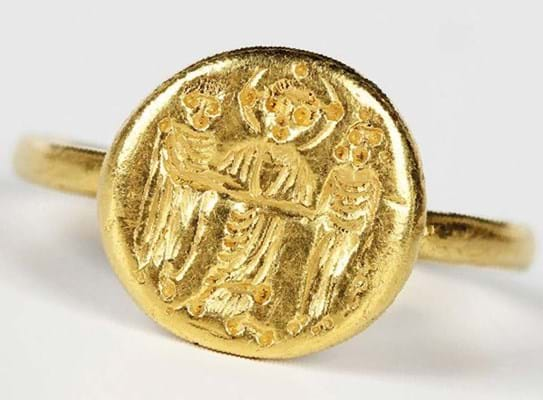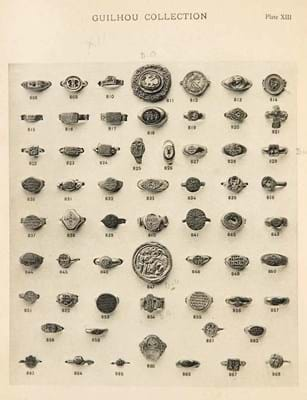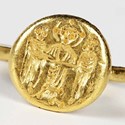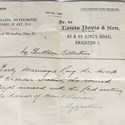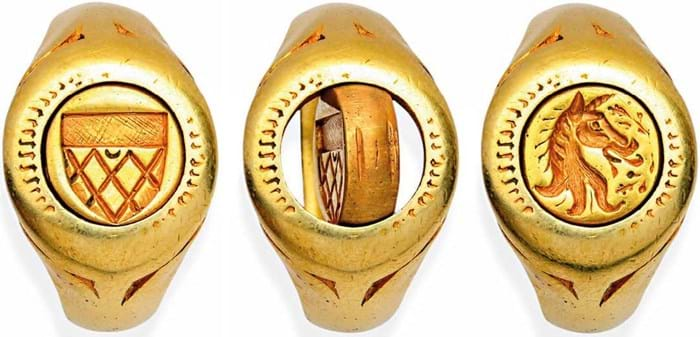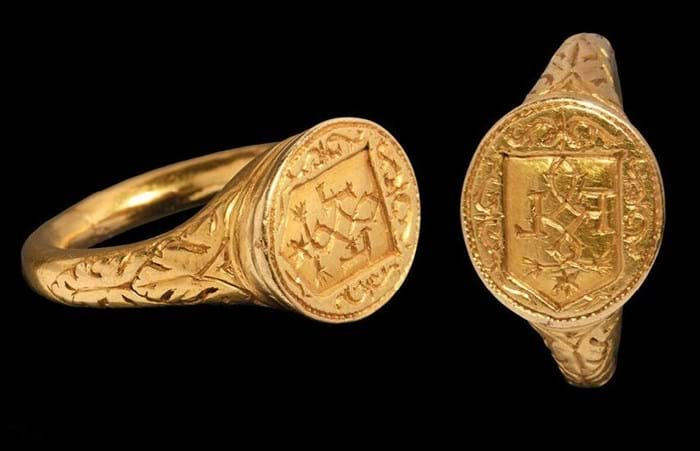The imagery was ultimately taken from coinage, specifically solidi celebrating the marriage of the Theodosian empress Pulcheria to the general Marcian that depict the standing couple blessed by Christ. Byzantine rings often had a dual purpose as portable amulets: and functioned as invocations against ill wishes.
The example that led Toovey’s (24.5% buyer’s premium) sale in Washington, West Sussex, on February 16, taking an unexpected £11,000 (estimate £600-900), came for sale with an old invoice from Brighton jeweller Lewis Davis & Son. It read: Ex Guilhou Collection, Early marriage Ring, the hoop of circular section, the round Bezel incised with the Lord inviting the hands of Man & Woman, Byzantine.
The reference to the collection of enigmatic Frenchman Eduoard Guilhou in this note is important. While little is known of the man himself, his massive collection of more than 1600 ancient, Byzantine and medieval rings was published after he died in 1912 by the art historian and private collector Seymour de Ricci (1881-1942). Sotheby’s auctioned the collection in 1937.
Although Guilhou’s archive was mostly undocumented, De Ricci was able to deduce that it comprised rings from many celebrated collections sold in the late 19th and early 20th centuries including those of Frédéric Spitzer (1893), Baron Jérome-Frédéric Pichon (1897) and Victor Gay (1909).
He pictures three similar Byzantine gold marriage rings of this type in The Catalogue of a Collection of Ancient Rings Formed by the Late E Guilhou listed as numbers 845, 848 and 861, this ring offered in West Sussex, probably made in Constantinople in the 3rd-7th centuries, appears to be number 845.
A Cumbrian in Bucks
A 17th century gold signet ring sold for £20,000 at Hansons (25% buyer’s premium) in Etwall, Derbyshire, on December 9 had been discovered on farmland at Thornton, Buckinghamshire, in 2018. However, its original owner had been Cumbrian nobility.
The ring has a rotating bezel engraved to one side with a unicorn head and to the other with coat of arms of the Curwen family of Workington. It had probably belonged to Thomas Curwen (1602-72), the second son of Sir Henry Curwen MP (1581-1623) who inherited the family estate following the death of his elder brother, Sir Patricius Curwen, 1st Baronet (c.1602-1664). The estate included the 15th century Workington Hall, where Mary, Queen of Scots sought refuge in 1568 in the immediate aftermath of her defeat at the Battle of Langside.
The unicorn head crest, which appears to the gateposts at the family seat, is an echo of early Curwen family links to Galloway. Thomas, who never married, was buried at Workington.
The ring was purchased by a UK bidder at twice the low estimate.
Merchant class
Estimated at £3000-4000, a Tudor merchant’s signet ring took £13,000 at TimeLine (25% buyer’s premium) in London on February 22. Most probably of English workmanship, it was cast with raised acanthus ornamented shoulders and set with an oval bezel bearing an incuse and reversed design of an entwined vine or knot with star below between the letters FL.
The initials would be those of a wealthy member of the merchant class and the ring used to seal or counterseal documents. A large wearable size, it was a family heirloom acquired by the owner's father-in-law before 1950.


